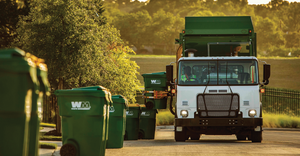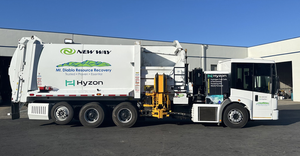Ghost Fishing Gear Gains International Attention and Who’s Doing What to Recover it

About 70% of heavy plastics floating in oceans may be lost fishing gear, estimates the United Nations, and it’s a problem that is very much on the international radar of both government and industry the past few years. Of all ocean trash, this glut of bulky gear is the most harmful to marine life, threatening both the ecosystem and fishing industry.
Thanda Ko Gyi, a professional diver and director for Myanmar Ocean Project, has seen firsthand how lost gear that’s drifted to sea, as well as gear intentionally tossed overboard, has ravished the waters off Myanmar, a remote but heavily populated country near Thailand.
She had been diving in that region looking for manta rays to learn how to protect this endangered species.
“Wherever we dived we saw fishing gear, and we started cleaning it up. It’s a problem that few know is going on in Myanmar and similar regions because they are unexplored,” says Ko Gyi.
She got a National Geographic Society grant through The Global Ghost Gear Initiative (GGGI), which is part of the global environmental nonprofit, Ocean Conservancy. And she began working with diving teams and the community to meet the project goal: exploring the waters of the Myeik Archipelago off the coast of Myanmar to assess the issue and recover gear.
In 2019 the muscle behind the Myanmar Ocean Project removed nearly two tons of gear from 87 sites in 43 days. But their effort only went so far in its impact. As quick as the divers could pull gear from the water, plenty more accumulated, and soon they were almost back to where they started.
The massive buildup is a combination of small bits intentionally tossed overboard and lost gear, caused when larger boats enter the waters and cut through local fishers’ nets. It’s this lost gear that’s most daunting—and deadly.
“It’s made up of multiple layers of nets, which could be several miles long, and they get caught on pinnacles (coral and rocks) and have to be cut out of them. You must be careful not to harm marine life that gets entangled in them … We see a lot of entangled rays, turtles, and other animals,” says Ko Gyi.
She and her team have two immediate focuses. One is getting the local government to enforce regulation around zoning so larger boats will not drive over the nets and create these hot spots of lost gear. The second focus, which they will work on soon, is to train local fishers to dive and retrieve the smaller pieces inundating their region’s waters.
The timing of the later focus is good and will be a win for both the villagers and the environment, Ko Gyi figures.
“The country just started welcoming tourists, so now there are a lot of fisherman that want to become pro divers and take tourists snorkelling. It will be a chance for them to make a livelihood in ways beyond fishing, which is how most people in Myanmar earn income. And they will have an important role. As tour guides, they will be the gatekeepers and can help prevent waste,” Ko Gyi says.
The residents of this otherwise pristine space do not know the harm the gear is causing, so the team enlightens them, hoping to encourage them to control what they can.
They give presentations, sharing photos and telling of what they see when they descend toward the ocean floor. And they invite the community to collect nets on the surface of the water and to free trapped marine life that may still be alive.
The team can’t travel now because of COVID-19, plus the monsoon season, which just ended, held them back.
“But when it’s easier we will establish collection points in villages to help them with their discarded nets and will work with the government in Myanmar to set up collections at ports. We will also work with the government to address the lost gear caused by bigger trollers by enforcing the fishing zones, which has not been consistent,” Ko Gyi says.
The work in and around Myanmar is one of 17 projects that GGGI has supported across six continents and more are underway, all focused on preventing, mitigating impact of, and or recovering lost gear.
The GGGI, based out of Washington, DC, has 115 member organizations around the world. Its latest news is that the U.S. joined this past summer. It is working with the U.S. government to support preventative measures and technology testing in the Caribbean; is collaborating with the Gulf of Maine in trap and big-gear retrieval; and is partnering with the National Oceanic and Atmospheric Administration to fund gear retrieval domestically and internationally.
“We want to be a space for everyone around the globe to have a voice and collaborate. Everyone, whether a nongovernmental organization or industry members with vessels, has a different approach, but they all have a role in coming up with real solutions,” says Joel Baziuk, deputy director of the Global Ghost Gear Initiative.
Blue Ocean Gear, a San Mateo, Calif.-based tech startup, is joining the work in the Caribbean to find gear that gets lost during hurricanes and storms. The company develops intelligent buoys with GPS for commercial fishing fleets and will install its technology on lobster traps to see where the gear is moving.
“The ability to locate the gear is a game-changer for these fishers who will be able to call up the information on their smartphones. If you can imagine having hundreds of thousands of dollars of business assets on water; it’s a volatile place. It may not be there when you come back for it,” says Kortney Opshaug, CEO of Blue Ocean Gear.
The sensors mainly detect buoy motion and relay when gear has been underwater, which not only helps locate it, but helps fishers to better understand ocean conditions to plan their trips.
Blue Ocean Gear’s work extends beyond the Caribbean and its collaboration with GGGI. In December it launched pilots at wild-caught fisheries and aquaculture (fish farms) in Nova Scotia where it is working with the Eastern Nova Scotia Marine Stewardship Society to deploy gear and analyze data. It has done similar work in Alaska.
Other domestic projects will entail working with East Coast lobster fisheries to help with a problem whereby whales get entangled in fishing gear.
The ghost gear problem has devastating impacts on more than one level.
Fishery stocks can be depleted because of ghost fishing where lost gear continues to fish and everything it captures dies. The dead fish then become bait for more fish, luring them into traps.
“That’s the cycle of ghost fishing. It’s terrible for the marine ecosystem, and it’s terrible for the industry that depends on those healthy marine ecosystems,” says Opshaug.
As far as her work with GGGI, she says, “I connected with them because the entire group is focused on the same issues as us, but globally. It made me realize we are part of a solution, but we could be part of a bigger piece and fit into the overall attack on the problem, while working with others.”
That will be important she says, because “There is no one silver bullet.”
About the Author
You May Also Like




